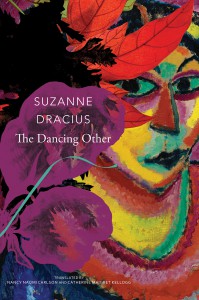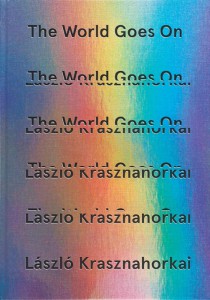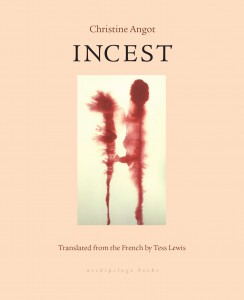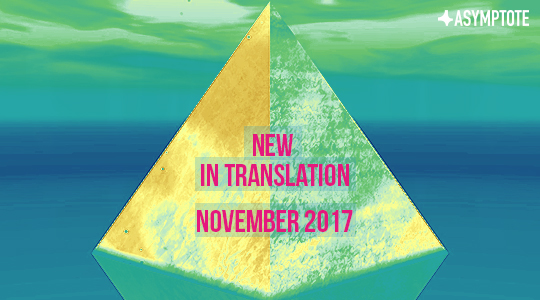Every month, batches of books arrive fresh on the shelves of bookstores around the world. Our team has handpicked three exciting new reads to help you make up your minds on what to sink your teeth into, including novels from Martinique, France, and Hungary.

The Dancing Other by Suzanne Dracius, Translated from the French by Nancy Naomi Carlson and Catherine Maigret Kellog, Seagull Books
Reviewed by Madeline Jones, Editor at Large, United States
The Dancing Other opens as our anti-heroine Rehvana stumbles out of a dingy apartment in Paris, just barely escaping literal branding by the other members of the Ébonis, or the “Sons of Agar”—an African god. Rehvana wants nothing more than to be included in and loyal to this insular community of Antillean immigrants that tries to emulate traditional Martinique culture—though how authentically they manage this aspiration is debated among some of Dracius’s other characters.
Rehvana’s boyfriend Abdoulaye is the group’s leader, whose temper has more than once manifested itself in blooming bruises across Rehvana’s face and arms. But the kind, protective Jeremy holds no allure for her. Jeremy and Rehvana’s formidable older sister, Matildana, tell her blatantly that a young woman such as her has no business slumming it with this cultish group of wannabes, but Rehvana both resents and resists her smarter, more pretentious, whiter sister’s warnings. She takes her newly enforced identity to its final phase by running away without a word back to the homeland, to Martinique, with another man she just met and who immediately consumes her thoughts and energies.
In Martinique, Rehvana relishes every piece of her new neighborhood and lifestyle, throwing herself into fixing up Enryck’s decaying family home and learning to cook traditional dishes with ingredients from their garden; and yet, the hot days blur her consciousness, the wild plants cut her hands and arms, and Enryck often doesn’t make it home for dinner anyway. Where he goes, she doesn’t know or ask. She waits for him, eating nothing, forgetting herself. She wants to fit in, above all, in this place that was once her home and suddenly now is again.
“Rehvana now hides her hair, too straight for her taste; she’s abandoned her regular sunbathing sessions—too shocking to those around her—because a well-bred Martiniquan woman wants to look Creole, not Negro, and takes great pains to avoid exposure to the sun. Anyway, the sunbathing had only managed to turn her peach-like skin more golden—not darker—making her look like a tanned tourist. She hates the sight of her pasty arms, and only wears long sleeves. She’s tucked away her flowing mane—too ‘White’ for her taste—under a crude, white cotton square, the way Haitian women used to do… She does all this for Enryck, and because it’s Antillean.”
She barely communicates with her family back in Paris, but Matildana finds her when she learns that Rehvana is pregnant. She flies to Martinique and discovers the squalor in which her younger sister is living, the wounds she’s incurred from the gardening and from Enryck’s jealous imagination. She meets the grumbling, brutish man who has taken possession of Rehvana’s love against all logic, who gambles and has suspicious friends. But Matildana has also done some math, and comes armed with the knowledge that Rehvana’s child is really Jeremy’s. But Matildana is powerless to bring her sister back. She rails against her sister’s indoctrination for the last time:
“I’ve gone astray, I’m guilty of shamelessly crossing the line in every sense, because what you call ‘return’ seems to me no more than a carnivalesque regression, and because I don’t practice systematic regression and I don’t espouse the extremism of a fanatic fundamentalist. Woe is me, a pox on me, shame on me! I am denegrified. You can’t stoop any lower than that . . . Yes, I forgot the catechism of that dear Abdoulaye—what a saint! Article one, identity: since I’m not wholly White at the start, if I don’t negrify myself, then I’m nothing. I’ve got no color or race, no identity or culture, I’m nothing… Because it’s so important, so primordial, to be an authentic something! Even if you’ve got to force yourself to do it, and use tricks to cultivate the authentic. There are Whites, Indo-Aryans, Blacks, real Negros, ‘people of color,’ Chinese people, Asians, Native Americans, Arabs, Jews, and so forth. You absolutely must classify people, or otherwise it creates havoc, and folks will no longer get their bearings…You can’t just be a man, you have choose a race—no mixing, no breaking ranks! . . . My goodness, you’ve got to know what you are and be proud of it! You’re so kind, Rehvana, for leading your poor, lost sister back to original purity!”
Dracius’s writing often feels more like a texture to run your hands over or a liquid to imbibe than like words on a page. She never anchors the action in a specific time and her tenses intermingle and overlap so that the reader must simply trust that Dracius knows what she’s doing and follow her into the wardrobe. It’s an immersive, if often disorienting, experience to read, but once one relinquishes the expectation of exposition or framework and simply dives into the swirling memories, colors, and scenes, the picture and figures solidify. The translation feels at times overly concerned with communicating the sonic and poetic effects of the original—a valiant aim—at the expense of the practical communication needed to really set the scenes or bring the characters to life. For long stretches when the rhythm and fluidity in English cohere, however, the writing is truly worth savoring. The search for identity is neither tangible nor logical, after all, so Dracius’s transmission of these two sisters’ struggle to find themselves while remaining intelligible to one another becomes an intimate, immersive blend of form and story.

The World Goes On by László Krasznahorkai, Translated from the Hungarian by John Batki, Ottilie Mulzet, and Georges Szirtes, New Directions Press
Review by Lindsay Semel, Director, Asymptote for Educators
László Krasznahorkai’s Hungarian short story collection, The World Goes On, rendered into English by esteemed Krasznahorkai translators John Batki, Ottilie Mulzet, and Georges Szirtes, doesn’t really contain periods. Or paragraphs. Sometimes there are section breaks. Having freed themselves from the ordinary obstacles of language conventions, the words and thoughts follow their own sense of gravity, their own trajectory, and stop where they hit into something. The effect is utterly three dimensional. The language has mass and direction of a sort usually reserved for physical objects. The content of the stories matches the form of the language, so that the text as a whole becomes a nearly tactile meditation on movement, form, resistance, and the potential that exists in the freedom beyond the rules that dictate them.
The reader experiences motion by inhabiting the body and gaze of the narrator, who in turn seems often to possess the bodies of his stories’ protagonists. In “Wandering-Standing,” the first story in the collection, he stands in a place where he cannot stay and from where he is too paralyzed by the mediocrity of his directional options to move. The narrator watches himself from a bird’s-eye-view, “he motionlessly starts off into the untamed world, in a direction—it doesn’t matter which, it could be any direction—and he doesn’t budge even an inch, already he has gone very far, and his wanderings in the untamed world have begun, because while in reality he is motionless, his hunched form, almost like a statue, engraves itself into an inability to be left behind here . . .” Later stories catalogue other flavors of motion. A drunk simultaneous interpreter comes-to inside a twelve-way Shanghai intersection, and against the backdrop of manic, unfettered speed, he has to drag himself back to his hotel. A post-office line inches forward as the narrator measures time by the number of people in front of him. Rockets launch into space, killing, overheating, or briefly incapacitating their passengers, whose molecules aren’t designed for such extraterrestrial speed and atmospheric change. A man sets out to run faster than the velocity of the earth. These juxtapositions of speed, direction, and viscosity heighten the impact of the descriptions, giving rise to the sensation that the reader is travelling with the character.
The counterpoint to movement is form, or structure. For example, in “A Drop of Water,” on the banks of the flowing Ganges River, an enormous man asks the narrator, “did you know that according to local tradition a single drop of the Ganges is in itself a temple?” He goes on to explore the notion through a detailed lesson on the structure of water. The form of a single water droplet becomes the cipher by which Varanasi, described as a tangled jumble of sacred and profane on the banks of the unidirectional river, becomes less impenetrable.
In “Obstacle Theory,” the reader learns (from a homeless drunk at a train station on Christmas Eve) that, at the conjunction of movement and form, there is obstacle. And these obstacles hold the world together in that, “everything that is in place, is there because it cannot fall any farther toward the earth, the force of gravity is pulling it down, but something doesn’t let it go . . .” A snowflake wants to fall, but wind resistance makes it do so gently, and the ground makes it stop entirely. The drunk wants to stand up and leave, but he bumps into his own drunkenness, which makes him fall down again. These examples inform the reader’s interpretations of coming stories and invite her to revise interpretations of previous ones.
The unpunctuated blocks of words, with their tangents and repetitions, can try a reader’s patience. But that patience is well rewarded. Seemingly unrelated stories, linked by form and theme, build a remarkably coherent, vivid, and nuanced whole. That this virtuosity is apparent in the English text speaks to the talent of the translators, all of whom have had a hand in building Krasznahorkai’s stellar English-language reputation.
Through The World Goes On, the reader wander-stands to Shanghai, Budapest, Varanasi, Berlin, Turin, Venice, Kiev, a locked auditorium, and outer space. After such an exhaustive tour, the narrator concludes with “I Don’t Need Anything from Here.” Having catalogued some of the world’s simplest charms, he states, “I would leave this earth and these stars, because I would take nothing with me, because I’ve looked into what’s coming, and I don’t need anything from here.” The final weight of attachment dropped, the reader is left with a delicious, soaring lightness.

Incest by Christine Angot, Translated from the French by Tess Lewis, Archipelago Books.
Reviewed by Giorgos Kassiteridis, Marketing Manager, Asymptote
“Your readers don’t understand a thing and they understand everything”
The torrential and chimeric prose of Christine Angot remarkably recreated in English by the 2017 PEN Prize awarded translator Tess Lewis cannot always be fully understood intellectually; her rhizomatic associations—incestuous, even—are visceral, vibrating, affective, accessible only if the reader surrenders to the spate of words that runs through Incest, finding a centre only to detach it and carry it away to a forbidden dance producing new variations, expansions, and offshoots: “a miracle of logical disorganization.”
A dim sludge of words—unattractive but fertile—that encapsulate insanity, incest, love, memories, and yearnings. Christine Angot begins her work with a chaotic flux triggered by her disassembled relationship; a three-month love affair with MC. The tangled first part generates a process of self-reflection: “I mix everything up, I go too far, I wreck everything … I want to stop making them.” She watches herself from the distance that the written word provides and attempts to trace the origins of this mental structure, to stop drawing all these entropic connections, mixing everything together. The text progresses in more abstractive strata from the chaos of the first part to a self-understanding that culminates in a juxtaposition of a dictionary definition of schizophrenia, sadomasochism, and homosexuality in an attempt to understand the origins of her paranoid logic. Nevertheless, these psychoanalytical classificatory categories will not reign in her analysis; they will be untied and become embedded in the same paranoid thinking she tries to explain. A lost love, a vehement struggle to understand the archaic substrate of her incestuous mind, her incestuous touch.
Her words are abrupt, disruptive, and confessional; a flickering language extracting traces and structures from “other voices, other texts, other things.” This is a polyphonic collage that forges a text with no centre, only nodes from where new roots emerge as frayed threads. With parallels to auto-fiction, a genre Angot refuses to associate with her work, this novel creates a space where imagination, potential futures, and pasts mingle with experiences, where the ‘I’ slips from the author to the narrator and gets lost in the vortex of language; it is language that speaks—the writer just writes.
Therefore, the translation of such viscous fluidity and polyphony into a different linguistic materiality would have been a challenging task. The translator might have had to immerse herself into these messy connections in order to draw new ones and to adopt an incestuous mental structure. The intertextuality and the slippery subjectivity of the narrator could have been demanding, as well as the peculiar structures and punctuation, which even the author acknowledges. The “bits of flesh” that Christine Angot left out on the pages to dry must have been fragile and resistant to translation. Nevertheless, Tess Lewis has attested her capacity to twist and turn in and through language(s) by winning the 2017 PEN Translation Prize for her translation of the novel Angel of Oblivion by the Austrian writer Maja Haderlap, published by Archipelago Books. The translator masterfully developed an intuitive relationship with the work of Christine Angot, endowing the English words with vibrating affectivity and ruptures, illustrating Hœpffner’s description of the practice as follows: “the abiding image of the translator is, then, of an unstable and even schizoid ouroboros, eating himself while expanding outwards, plagued by contrary urges.”
Christine Angot’s book trigger both lauding and severe criticism, creating a work worth talking about; shedding light on issues that are not easily comprehensible—taboos—not from the position of an expert but from her own particularity, her own manner of writing. Voices echoing from the fractures, this is Incest: a collective adventure for the one that writes and the ones that read. There is nothing to say, only to talk about, to become part of the sludge.
*****
Read more reviews:

